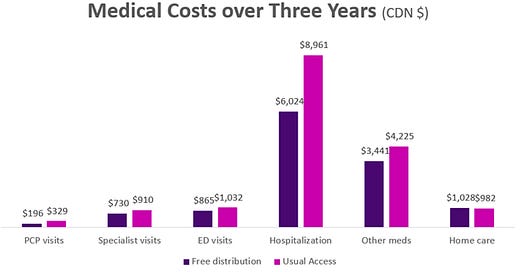Waiving out of pocket costs for basic primary care medications lowered total cost of care
Many employers use “value-based insurance design” (VBID) in their pharmacy benefit design, offering selected high value medications, like those to treat diabetes, high cholesterol, high blood pressure and asthma, without cost-sharing. Canadian researchers went one step further, providing 128 commonly used medications without cost to patients to observe the impact on total medical costs. These drugs are largely generic and inexpensive and cover a wide range of chronic and acute illnesses. They asked whether these “free” drugs would lower the overall cost of medical care.
The answer, published last week in JAMA Health Forum, is that those randomly assigned to “free” medications had statistically significant lower overall health care costs, with fewer hospitalizations and emergency department visits. This is great news! Most interventions like this are “cost effective,” offering better health for a reasonable price, but not frankly “cost saving.” The authors previously published an analysis showing that those randomized to “free” drugs had higher rates of adherence to prescribed medication.
A few caveats are in order. This study explicitly recruited adults who said that they had skipped medications because of cost. It was performed in Canada where many have no pharmacy insurance, and both drug prices and out-of-pocket medical costs are far lower than in the United States. Further, the researchers did not include the cost of medications when calculating savings.
Source: Persaud, et al JAMA Health Forum May 26, 2023 LINK
Implications for employers:
- This study supports value-based insurance design - demonstrating that increased adherence to medications which have no out-of-pocket costs can lower overall hospitalizations and emergency department visits.
- Medical savings in Canada are not directly applicable to potential medical savings in the U.S.
- Employers can work with their PBM to deploy benefit designs that ensure member access to high-value, low-cost preventive medications such as by ensuring the products bypass the deductible in HDHP’s and/or assigning $0 cost share for preventive medications
- When WTW surveyed employers last year, 64% said they were taking steps to improve health care affordability, and 41% said they were seeking to add or enhance low- or no-cost coverage for certain benefits.
Instead of a long note on Friday, this week I’m again spreading my posts through the week. Please let me know whether you’d rather this newsletter as one long note or 3-4 shorter notes.



